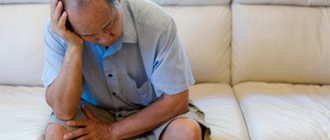Kleine-Levin syndrome is a periodic, spontaneously occurring disorder of sleep and wakefulness in the form of fairly large periods of sleep. The dream can last for several days or even weeks. A sick person wakes up for a short period of time, but at the same time does not behave adequately, absorbs all kinds of food around him. Periods of such “hibernation” are then amnesiac for the patient. During the interictal period the person is absolutely healthy. Kleine-Levin syndrome is a very rare pathology, but its unusual symptoms attract the attention of researchers. Let us also find out what kind of pathology this is, why it occurs, how it is characterized and how it is treated. This article is exactly about that.
What it is
Sleeping beauty syndrome is also called Kleine-Lewin syndrome, named after those who discovered it. This is a condition in which a person spends most of his time sleeping. Sleep lasts from several days to several weeks. Wakefulness takes a very short period, during which the patient behaves extremely inappropriately. He shows aggression, simply sweeps away all the food in his path.
In the intervals between sleep and wakefulness, a person is the same as usual. Except that sleep can overtake him at any time and in any place.
In world medical practice, 200 cases of Kleine-Levin syndrome are known. People started talking about him for the first time in 1786. Then the research was carried out by the French doctor de Beauchaine. In 1925, Willi Kleine, a German psychiatrist, took up the description of the pathology. He compiled a detailed description of the signs and clinical picture of the syndrome based on work with 9 patients.
In 1936, Max Lewin, a neurologist from the United States, identified a connection between periods of hibernation and inappropriate eating behavior. In his opinion, the “sleeping beauty” syndrome is a neurological disease that has nothing to do with psychiatry.
Symptomatic signs
Signs of amblyopia cannot always be detected in a timely manner, since with a mild degree of the disease there is no clinical picture, and only a qualified specialist can suspect the presence of disorders.
Symptoms of amblyopia appear as follows:
- decreased vision in one or both eyes that cannot be corrected with glasses;
- visual perception of objects and their spatial characteristics (size, location of objects relative to each other) is disrupted;
- the symptoms of strabismus (if present) intensify, that is, the asymmetrical arrangement of the corneas relative to the inner corners and outer edges of the eyelid becomes more noticeable;
- The child does not absorb visual information well.
Causes and conditions of the syndrome
It is still not known exactly why Kleine-Levin syndrome develops. Neither MRI nor studies of cerebrospinal fluid and hormonal levels have revealed what provokes the development of pathology. But scientists have identified a number of theories in this regard.
- Genetic. If someone in your family has suffered from Kleine-Levin syndrome, the likelihood that you will have it increases dramatically. At the genetic level, changes occur in the brain associated with the part of the brain that controls sleep and hunger. As proof of this theory, they cite the example of Ashkenazi Jews, among whom this disease is most common.
- Disturbances in brain function after neuroinfections. In first place are meningitis and encephalitis, which are characterized by inflammation of the membrane and damage to the hypothalamus.
- The theory of hormonal imbalance. Most often, Kleine-Levin syndrome manifests itself in adolescence, when the amount of hormones reaches either its highest point or, conversely, its lowest point. Sleep in this case is considered the body’s protective reaction to these fluctuations.
- Theory of death or deficiency of orexin neurons. These cells are responsible for the correct alternation of periods of wakefulness and sleep. They also regulate nutrition and energy. If they are lacking, muscle tone decreases, weakness and drowsiness appear.
Recent research has revealed another theory - hypothalamic-pituitary dysfunction. According to her, the “sleeping beauty” syndrome develops as a result of metabolic disorders in the hypothalamus.
There are also factors that provoke the development of pathology:
- disturbances in the intrauterine development of the child;
- brain injuries;
- viral infections;
- stressful situations.
The presence of malignant or benign neoplasms can be added to the same list.
Stages of severity of pathological processes
Amblyopia manifests itself from a slight decrease in visual function to a sharp deterioration in the visibility of objects. In the first stage of the disease, it is almost impossible to timely detect visual impairment in a child. A weak degree of amblyopia (visual acuity 0.4-0.8) is diagnosed during preventive examinations by an ophthalmologist.
The average degree (visual acuity 0.2-0.3) of impairment may also have no clinical signs and is detected during an ophthalmological examination.
With a high degree of amblyopia, the child’s vision deteriorates (visual acuity 0.1-00.5), visual perception of information decreases.
The highest degree of impairment (from 0.04 and below) is manifested by a sharp decrease in vision; the child cannot see objects.
Symptoms
The clinical picture of Kleine-Levin syndrome looks like this:
- A person sleeps at least 18-20 hours. He only wakes up to eat and go to the toilet. It is impossible to wake him up.
- Attacks can even last for several days. In medicine, there are cases where a patient slept for 6 weeks in a row.
- Such a dream can hardly be called complete. The person does not feel rested. Therefore, after a short period of wakefulness, he goes back to sleep. At the end of the attack, he feels a surge of strength and energy, and along with it, severe hunger.
- When the patient does not sleep, he eats. Moreover, everything he sees on his way, without understanding the compatibility of products. There is nothing surprising if he eats herring with honey or, for example, snacks on a cake with pickled cucumber. By the way, in this state a person eats a lot of sweets.
- While awake, the patient exhibits aggression, irritability, and excessive emotional arousal. On top of that, he experiences euphoria and hypersexuality. Hallucinations can also be added here. These symptoms of sleeping beauty syndrome can occur several hours before a person falls asleep for the first time.
- To the above symptoms are added excessive sweating, blue discoloration of the hands, feet, lips and the area of the nasolabial triangle.
- During an attack, the level of glucose in the blood changes.
- After an attack, a person becomes the same as he was before. And the attack itself seems to fall out of his memory.
Interestingly, there is no way to determine the disease between attacks. Even after examination, the person will be absolutely healthy. The only sign is weight gain.
Most often, about six months pass between attacks. The disease appears unexpectedly and disappears just as unexpectedly. The attacks become shorter, and the period of wakefulness, on the contrary, increases. And, in the end, life returns to normal.
The duration of Kleine-Levin syndrome may vary. According to medical literature, the maximum age is 18 years.
Duration of the disease
This is a chronic disease for which there is no cure. Episodes may occur every 3-6 months. They last for 2-3 days or more. The maximum period was six weeks. In the intervals between them the person looks quite healthy. Apart from the violations described above, he is no different from his peers. However, periodic loss from real life has a strong impact. Such people are developmentally delayed and cannot work fully. When the patient wakes up after an attack, he does not recognize anyone, does not understand anything. This continues until it is completely completed. Usually, over time, relatives begin to notice the approach of an attack. The patient becomes more aggressive and begins to eat a lot, as if he is stocking up for the period of hibernation.
Diagnostics
First, the doctor determines the severity of the symptoms described above. Afterwards, instrumental diagnostics are prescribed:
- Electroencephalography. Shows the functional activity of the brain. In Kleine-Levin syndrome, the device records peaks in the temporal and temporo-parietal zones.
- Polysomnography. Explores sleep, specifically its 3rd and 4th phases. Reveals a decrease in the time it takes to fall asleep.
- PET-CT brain. During an attack, it detects disturbances in the process of blood circulation in the area of the thalamus and hypothalamus.
Based on the results of the examination, the doctor draws up a plan for further action.
Treatment
It is impossible to say definitively what treatment will be needed. This is because it is almost impossible to identify the cause of the development of Kleine-Levin syndrome. But in most cases, two types of therapy are carried out: medication and psychological.
Taking medications
Medicines are prescribed in severe cases. These are the following groups of drugs:
- Psychostimulants. Helps cope with drowsiness. The most commonly used medications contain caffeine.
- Nootropics. They normalize metabolism in brain tissue, improve memory, blood circulation and intellectual activity.
- Normotimics. Eliminate irritability, aggression, hot temper. They also normalize the time of sleep and wakefulness.
If the “sleeping beauty” syndrome has not reached critical conditions, it is better not to take medications. The disease will go away on its own.
Working with a psychotherapist
Psychotherapeutic techniques in the treatment of Kleine-Levin syndrome make periods of sleepiness shorter. In addition, this is a personal opportunity to support a person. The following techniques are commonly used:
- Psychoanalysis. The patient is instructed to express everything that worries him now or previously worried him. He needs to be as frank as possible, even tell what he hid from his family and friends. This is the only way to find the cause of the “sleeping beauty” syndrome.
- Art therapy. Involves creative activities. This could be drawing, modeling, puppet theater, etc.
- Dreams in reality. Otherwise called symboldrama. A person is given a life situation from which he needs to find a way out. Option 3: tragic, dramatic, optimistic. Depending on the choice, the psychotherapist decides whether the patient needs help or not.
You cannot try to cure Kleine-Levin syndrome on your own. Self-medication in this, as in other cases, leads to a worsening of the patient’s condition.
Prognosis and prevention
The prognosis for the pathology is favorable. Over time, the symptoms of Kleine-Lewin syndrome become less pronounced and then disappear completely.
As for prevention, there are no ways to prevent an attack. Nobody knows when it will start. But there is an opportunity to at least slightly alleviate the patient’s condition:
- Allocate no more than 8-9 hours of sleep at night.
- Also sleep during the day. 35-40 minutes is enough.
- In the evening before going to bed, do not engage in activities that require physical or mental activity.
- Do not eat chocolate, fatty or heavy foods before bed. It is also not recommended to drink alcohol and energy drinks.
Following these tips will help reduce the severity of symptoms and live with the “sleeping beauty” syndrome.
Statistics
In total, 1000 patients with this diagnosis have been registered in the world today. Of these, 70% are men. Medicine cannot help them in any way, so their relatives have to keep a round-the-clock watch, quit their jobs and forget about a normal, ordinary life. It should be noted that in most cases the symptoms gradually soften and become less pronounced. While the first attack may last more than 10 days, subsequent ones are usually shorter. The period of remission between them increases, however, bulimia may well cause excess weight gain.
Stories of people with Kleine-Levin syndrome
The world learned about the British Helen Waters in 2014. She was born in 1977. As a child, she was considered slow and clumsy. Therefore, the girl had no friends among her peers. She even spent her summer holidays alone. The doctors thought it was just laziness, so they didn’t conduct an examination or make a diagnosis.
In her youth, Helen did not become more active. She was constantly haunted by a feeling of fatigue. In 2009, she fell ill with the flu. After treatment, I hoped to start working, but I fell asleep for a whole 3.5 weeks. Her parents were only able to wake her up and feed her a few times. After fully waking up, everyone was convinced that Helen was sick with something.
From that moment on, tedious trips to hospitals began. Doctors, tests, examinations could not really say anything. At first they thought it was depression. But the prescribed medications did not help. And only after additional research was carried out, experts were able to understand what happened to the girl. The diagnosis, as you understand, is “sleeping beauty” syndrome.
Now Helen cannot live without medication. If she tries to at least reduce the dosage, the period of wakefulness is sharply reduced. An unpleasant consequence of constant sleep was partial memory loss. Sometimes a girl does not recognize her family and friends in a photo from a family album.
Risk factors
Some pathological conditions and unfavorable factors can lead to the development of functional disorders of the visual analyzer:
- ametropia - deviation of the refractive power of the eye from age-related values;
- strabismus;
- cerebral palsy;
- mental development disorder;
- III and IV degree of prematurity of the child;
- underweight newborn;
- the presence of ophthalmological diseases in close relatives (amblyopia, strabismus, lens opacity).
The presence of bad habits in pregnant women (smoking and drinking alcohol) increases the risk of developing visual system dysfunction several times.








